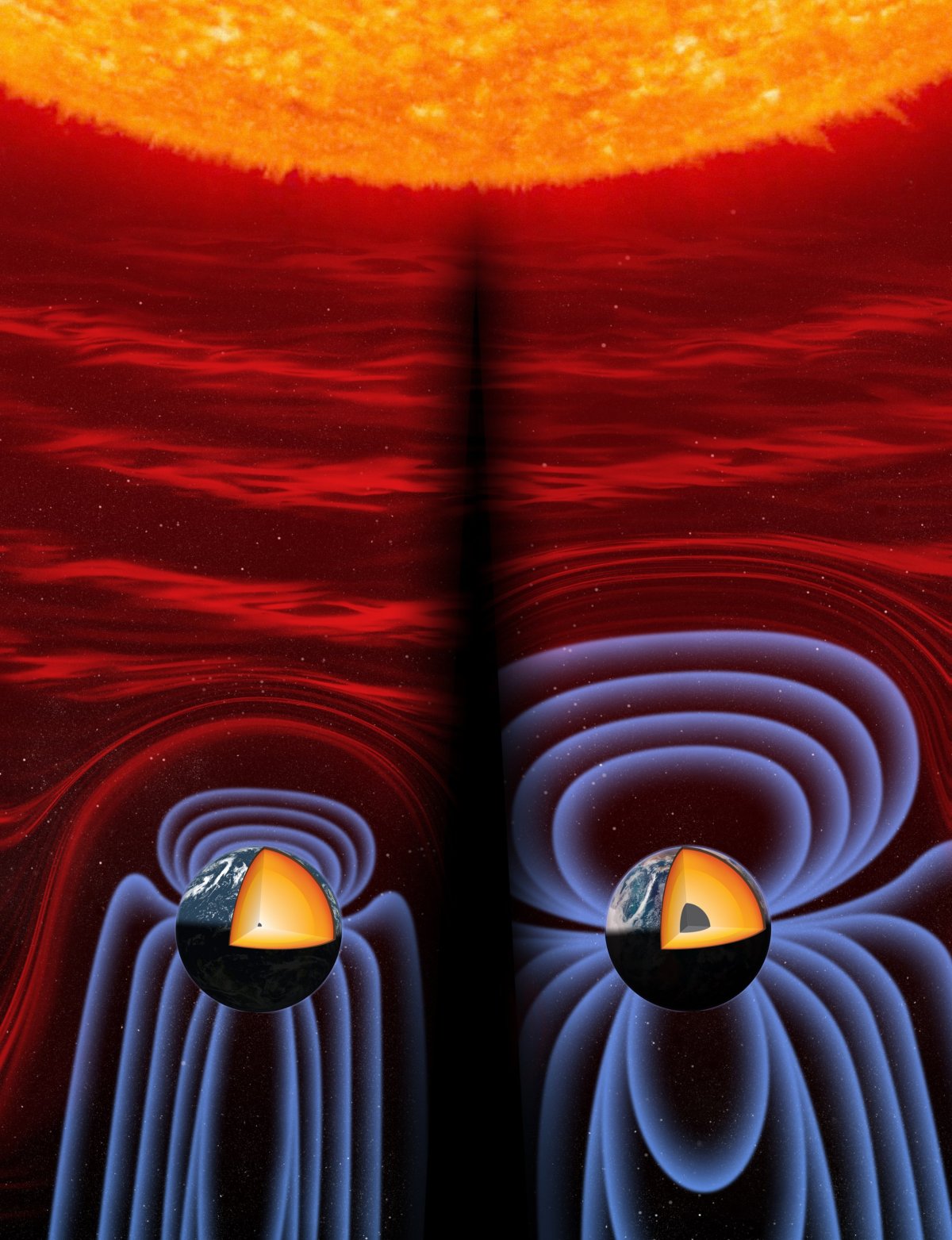About 565 million years ago, the strength of Earth's magnetic field dipped to its lowest point and almost collapsed completely, scientists have discovered. However, at this point, the planet's inner core started to solidify, providing a new energy source to drive the magnetic shield "just in the nick of time."
The discovery, published in Nature Geoscience, provides a new insight into the formation of Earth's core—a subject that has been debated for over 80 years.
Earth's magnetic field is thought to be generated deep down in the planet's core. This consists of a solid ball of iron surrounded by a liquid metal. As the planet rotates, the liquid iron moves, forming electric currents that produce the magnetic field.
Without a magnetic field, the planet would have had no protection from the solar wind—charged particles that flow from the sun and travel through the solar system at around a million miles per hour. These particles could have the interacted with Earth's atmosphere and slowly stripped it away, leaving the planet a barren landscape like the one we see on Mars today.
In the latest paper, a team of researchers led by Richard Bono of the University of Rochester in New York, were looking to find out when Earth's core solidified by analyzing rocks that carry information about the geomagnetic field. "Unknowns in Earth's thermal evolution have led to a wide range of potential ages for the solid inner core," study co-author John Tarduno told Newsweek. "This range spans more than 2 billion years of Precambrian history.
"Numerical models predict that the magnetic field would be unstable at the onset of inner core growth. But the paleomagnetic record is relatively sparse, so this has led to debate," he said.
The solidification of Earth's core would have provided a boost of energy to the planet's geodynamo—the formation of the magnetic field in the liquid outer core. "Liquid iron in the outer core convects, carrying with it magnetic field lines that twist, continuously regenerating the field. Without the convection there would be no core magnetic field," Tarduno explained.
This boost should have left a mark in the rock record. After taking measurements from rock samples taken from Sept-Îles in Quebec, Canada, researchers found a prolonged period where Earth's magnetic field was very weak—about 10 times less intense than it is today. This period of weakness lasted for about 75,000 years—far longer than any changes that occur when the field flips or changes direction.
The authors say the magnetic field intensity was so low that the geodynamo was on the verge of collapse. "As Earth evolved, the energy to drive convection gradually decreased, until a critical point 565 million years ago marked by the extremely low magnetic field intensity," Tarduno said. "The growth on the inner core provided a new source to drive convection and the geodynamo."
Essentially, a big boost of energy was needed to drive the geodynamo and stop the magnetic field from collapsing—and the solidification of Earth's core would have done just that.
Tarduno continued: "If the geodynamo had collapsed entirely, Earth would not have been protected from the solar wind, which can erode the atmosphere and eventually rob water from the planet."
In an accompanying article, Peter Driscoll of the Carnegie Institution for Science said scientists had previously interpreted the weak magnetic field 565 million years ago as being the result of "rapid tectonic motion, hyper-frequent polarity reversals, and even an equatorial dipole."
However, he said that if the latest research is right, "the nucleation of the inner core may have occurred right in the nick of time to recharge the geodynamo and save Earth's magnetic shield."

Uncommon Knowledge
Newsweek is committed to challenging conventional wisdom and finding connections in the search for common ground.
Newsweek is committed to challenging conventional wisdom and finding connections in the search for common ground.
About the writer
Hannah Osborne is Nesweek's Science Editor, based in London, UK. Hannah joined Newsweek in 2017 from IBTimes UK. She is ... Read more
To read how Newsweek uses AI as a newsroom tool, Click here.








